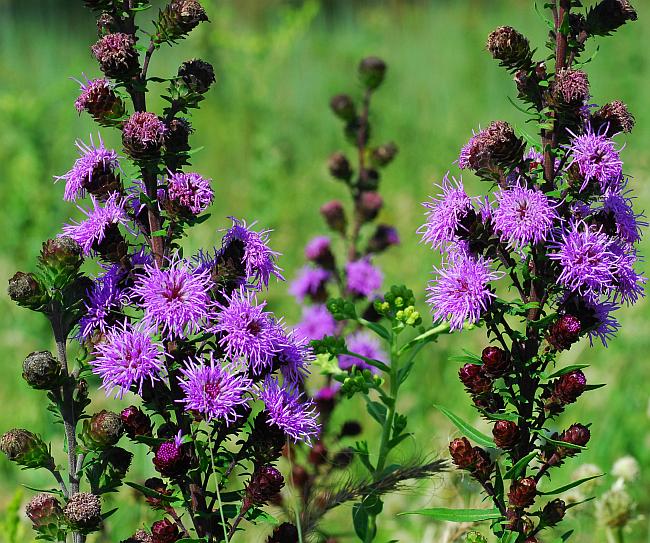Liatris scariosa (L.) Willd.
Blazing Star

Native
CC = 9
CW = 5
MOC = 18
SRank = S2
© SRTurner
Liatris scariosa (L.) Willd.Blazing Star | |
 |
Native CC = 9 CW = 5 MOC = 18 SRank = S2 |
© SRTurner |
|
Family - Asteraceae/Eupatorieae Habit - Perennial forb from a globose to ovoid corm. Stem - Ascending to erect, to 2 m, densely pubescent with short curled hairs, sometimes nearly glabrous toward base.
Leaves - Alternate, simple. Basal leaves petiolate, the blades mostly 10-50 cm long, 25-55 mm wide, oblanceolate to elliptic, the surfaces glabrous to sparsely short-hairy along the midvein, also usually minutely hairy along the margins, green, with 1 main vein, grading gradually to shorter stem leaves, these mostly sessile, 3-15 cm long, narrowly oblanceolate to more commonly narrowly oblong-elliptic, the uppermost often linear.
Inflorescences - Elongate, relatively open racemes of well-defined, loosely spaced heads, the inflorescence axis readily visible. Mid-inflorescence heads on stalks 12-40 mm long, usually with several small, loosely spaced bracts.
Heads - Discoid, with 29-80 disc florets, the terminal head usually larger than the others. Involucre cup-shaped, to 17 mm long. Bracts in 4-6 unequal, overlapping series, broadly ovate, ascending to appressed, mostly with narrow, thin, pale to dark purple margins, these nearly entire to shallowly scalloped, the main body appearing flat or nearly so.
Florets - Ray florets absent. Disk florets with the corollas 9-11 mm long, purple, the tube glabrous or hairy on the inner surface. Pappus bristles barbed.
Fruits - Achenes 4.5-6.5 mm long.
Flowering - July - October. Habitat - Upland prairies, glades, ledges, savannas, upland forest openings, pastures, open grassy disturbed areas. Origin - Native to the U.S. Lookalikes - L. aspera. Other info. - This species is somewhat uncommon in Missouri, reported from a band lying mostly along the eastern and southern portions of the state. Beyond Missouri its range extends mostly northward and eastward, though it appears to be reasonably common only in Michigan. The plant is easily recognized as a blazing star by general appearance, and could be confused with L. aspera, which is much more common. The two are easily distinguished when flowering. L. aspera bears its flowering heads on short stalks, and the involucral bracts have a distinctive "pouched" appearance, with margins which appear irregularly ragged and torn. In contrast, L. scariosa has long-stalked heads, at least toward the center of the inflorescence, and phyllaries which are mostly flat. Photographs taken at St. Joe State Park, St. Francois County, MO, 9-10-2012, Shaw Nature Reserve, Franklin County, MO, 8-18-2006, 8-1-2007, 8-20-2017, 9-5-2017, and 9-14-2024 (SRTurner). |